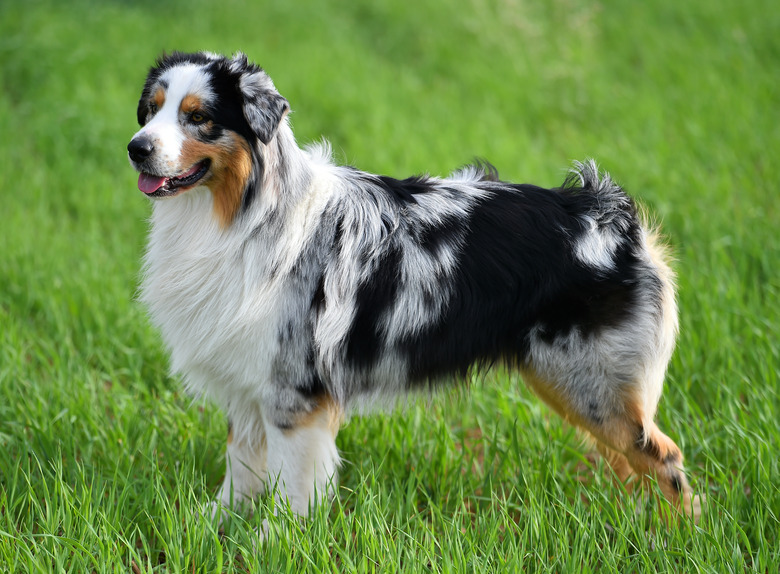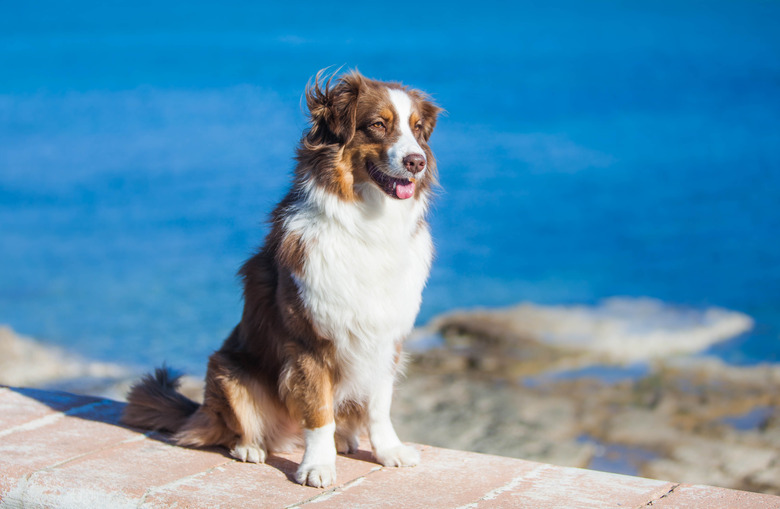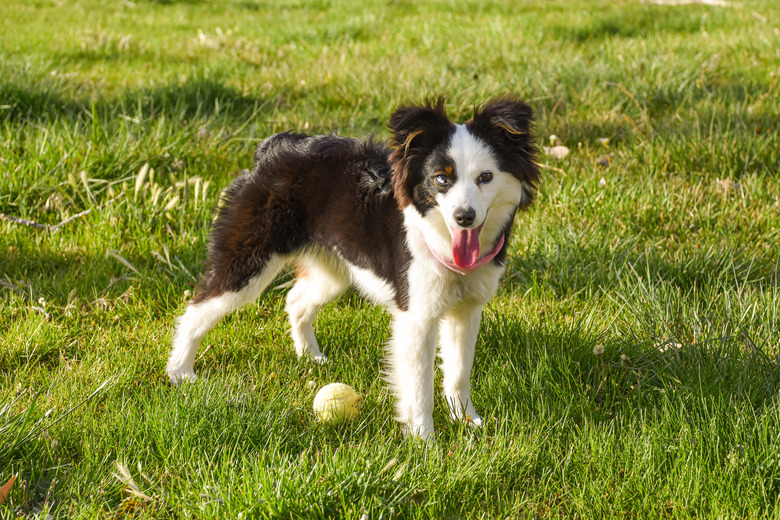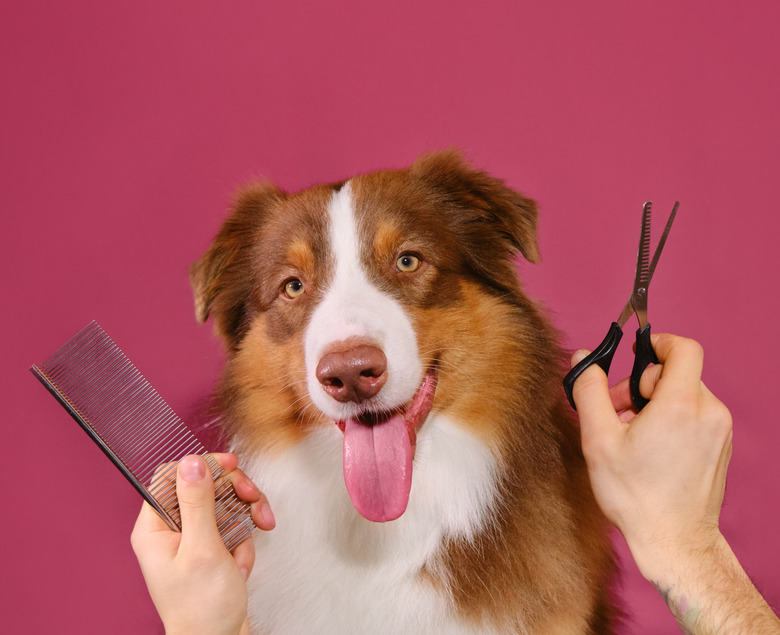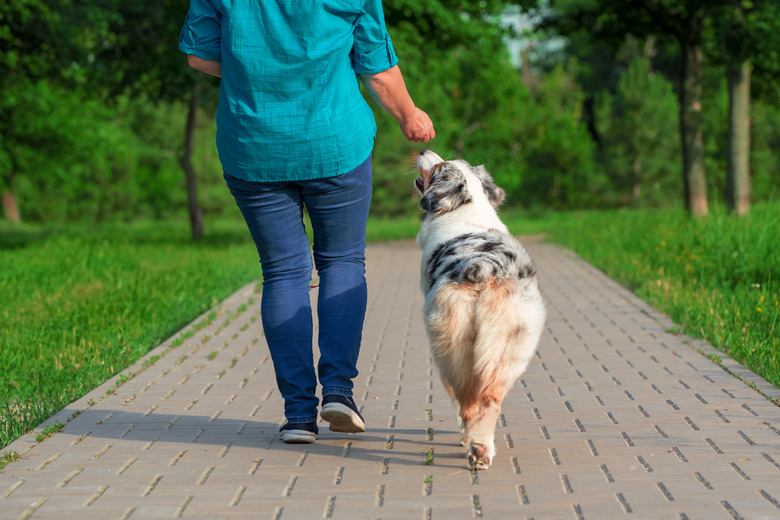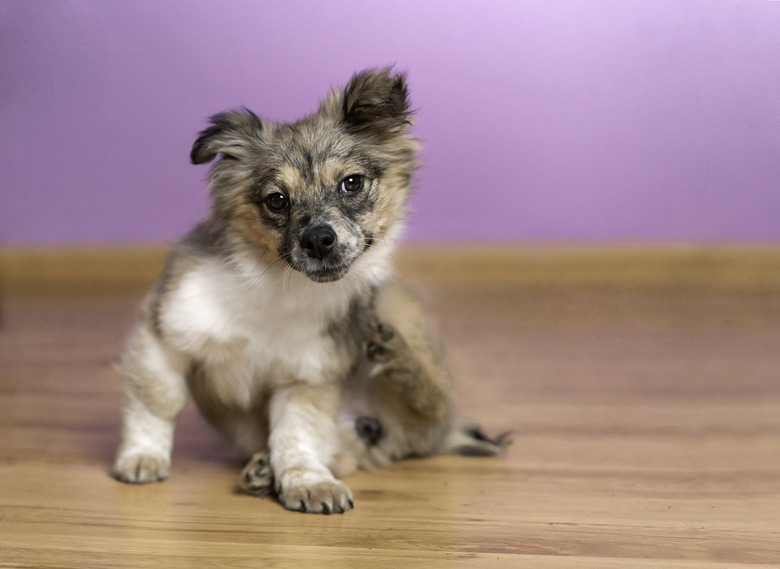Australian Shepherd Dog Breed Information & Care
Australian shepherd quick facts
Height: Females: 18 – 21 inches, males 20 – 23 inches
Weight: Females: 40 – 55 pounds, males: 50 – 65 pounds
AKC Breed Group: Herding group
Lifespan: 12 – 15 years
Coat length: Medium
Coloring: Black, blue merle, red merle, or red. White markings and/or tan or copper points are accepted. Eyes may be amber, brown, or blue in color.
Grooming needs: Medium
Friendliness: Breed alone is not an accurate predictor of an individual dog's personality. However, Australian shepherds are generally regarded as intelligent and exuberant.
Australian Shepherd Dog Breed Information & Care
Australian Shepherd Dog Breed Information & Care
Australian shepherds, lovingly referred to as "Aussies," are a popular breed on farms and ranches and that can make for an excellent companion for the right family. These beautiful dogs are hard-working, intelligent, and loyal. They can be protective and have a very high energy level, which means this breed is not for everyone. Carefully consider the breed's personality and care requirements before deciding if an Aussie is the right choice for your family.
Australian shepherd dog breed history
Australian shepherd dog breed history
Despite their name, the Australian shepherd we know today is an American dog breed. The breed was developed in America and can trace its roots back to the shepherd dogs the Spanish Basque sheepherders from the Pyrenees region in Spain brought to Australia. There, the dogs were crossed with other breeds including border collies and collies.
The mixed-breed dogs were then brought to America and called Australian shepherds. Breeders continued to develop the herding breed and after World War II, the breed's athleticism and herding instincts made them a popular working breed for ranchers. They were also a common sight at horse shows and rodeos around the country and also appeared in movies and TV shows.
The breed was recognized by the American Kennel Club (AKC) in 1991 and admitted into the herding group in 1993. They are the 12th most popular AKC dog breed, as of 2022.
Australian shepherd dog breed characteristics
Australian shepherd dog breed characteristics
Aussies are medium-sized dogs with weather-resistant, medium-length, double coats. They come in several different coat colors including black, blue merle, red merle, and red. Any of these colors may have white markings or tan points.
They have almond-shaped eyes that may be any shade of amber, brown, or blue. The eyes may be the same or different colors and marbling in the eyes is accepted.
The breed has a naturally bobbed tail and in some cases, the tail is docked to prevent injury and infections in working dogs. Docking the tail is not done or recommended when it is done just for appearances. The dogs also have feathering — which means longer, straight, fringe hair — on their britches and forelegs.
What is a mini Australian shepherd?
What is a mini Australian shepherd?
A mini Australian shepherd may look like a smaller version of the Australian shepherd. However, they are actually a completely different breed. The smaller dogs were originally known as miniature Australian shepherds, but when the breed was admitted into the AKC, the name was changed to miniature American shepherds.
Australian shepherd dog breed temperament & training
Australian shepherd dog breed temperament & training
Australian shepherds are eager to please and need plenty of mental stimulation. While they are considered smart dogs, obedience training can be a challenge at times as the breed is very high-energy. Novice pet parents may find it quite difficult to harness the energy and help their dog focus on learning cues. The breed thrives when they have a job, such as:
- herding cattle or sheep
- working as a service dog
- competing in agility
The breed is generally very good with young children but may not be as affectionate with all family members and other dogs as some other breeds. Keep in mind that Aussies have a herding instinct and without proper training, they may be tempted to try to herd children and other pets in the household.
Are Australian shepherds smart?
Aussies are smart dogs with above-average intelligence. According to Stanley Coren, a canine psychologist, the Australian shepherd ranks 42nd out of the 138 breeds he ranked. Of course, intelligence is difficult to quantify in canines and each dog is different. While these dogs may not learn new commands as quickly as some other breeds, they excel when working as herding dogs and need very little training to do so.
Do Australian shepherds bark a lot?
Australian shepherds do bark and they are likely to be more vocal than quiet dogs that only bark to alert. However, they are not extremely vocal and don't generally bark at the slightest provocation.
Grooming an Australian shepherd dog
Grooming an Australian shepherd dog
Australian shepherds have a medium-length, double coat that is surprisingly easy to care for. For most of the year, weekly brushing is plenty to keep your Aussie's coat healthy and free of knots and matting. However, when your dog is shedding their undercoat, expect to brush them more frequently, preferably with an undercoat rake.
The dogs also benefit from an occasional bath. The frequency can vary depending on the environment where you live and walk your dog and how dirty they get while playing. Make sure to use a shampoo designed for dogs that won't irritate their skin.
Other grooming tasks include:
- Trimming your dog's nails regularly, including the dew claws
- Checking and cleaning the dog's ears
- Brushing your dog's teeth
Fortunately, the breed does not tend to drool, so the fur on their face and chest tends to stay fairly clean.
Do Australian shepherds shed?
Aussies are generally considered moderate shedders and shedding may be worse in spring and fall. Regular grooming will help reduce the amount of hair you find on your floors and furniture.
Are Australian shepherds hypoallergenic?
Australian shepherds are not hypoallergenic dogs. As with all dogs, Aussies have proteins in their skin, saliva, and hair. Since Australian shepherds do shed, the hair and dander in the home can trigger a reaction in people who have a pet allergy.
Australian shepherd exercise & health
Australian shepherd exercise & health
Australian shepherd dogs are high-energy dogs and they need plenty of exercise to stay happy and healthy. At a minimum, they need an hour or two per day to run and play in a large, enclosed area. Be sure to walk, hike, or run with your Aussie daily and consider playing games of frisbee.
This activity will help to manage their energy levels, but the breed also needs mental stimulation. If you don't live on a farm where the Aussie can be a working dog, consider participating in canine sports or another organized activity. Some good dog sports for these athletic dogs include:
- herding trials
- obedience
- agility
- dock diving
- flyball
If you want to make a difference in your community, consider volunteering with your local search and rescue team as many Aussies also do well as search and rescue K9s. They also do well as service or therapy dogs.
The breed is typically very healthy, but there are a few genetic health problems that may affect the breed. These include:
- cataracts
- some forms of cancer
- epilepsy
- hip dysplasia
- elbow dysplasia
- collie eye anomaly (CEA), a condition that can cause blindness or partial vision loss.
Responsible Australian shepherd breeders will screen their dogs for these health conditions. Before getting a puppy, be sure to request to see the results from any DNA tests, ophthalmology exams, and hip and elbow evaluations. The Australian Shepherd Club of America has a list of questions to ask to make sure you find a healthy puppy.
Take your Aussie in for regular veterinary check-ups and keep them up-to-date on all of their recommended vaccinations and heartworm medication. Don't forget to use flea and tick prevention.
Are Australian Shepherds OK to be left alone?
A well-trained Australian shepherd who is getting plenty of exercise and mental stimulation can be left alone for a period of time. However, if the dog isn't getting the exercise they need, or if they are frequently left for extended periods of time, they are likely to get bored and become destructive.
Raising an Australian shepherd puppy
Raising an Australian shepherd puppy
When raising an Australian shepherd puppy, it is important to start socializing and training your pup as soon as possible, especially if you have children or other pets in the household. It is important to supervise your new puppy's interactions with children as Aussies may attempt to herd children or other small pets. Reward good behavior with plenty of positive reinforcement.
It is best to have a regular schedule that includes:
- meal times
- potty breaks
- playtime
This structure will help you to prevent accidents in the house and ensure your puppy is staying active and learning throughout the day.
This can seem daunting at first, but as your pup grows, they will need fewer feedings and potty breaks, although they will always need plenty of exercise.
What are the pros and cons of an Australian Shepherd?
What are the pros and cons of an Australian Shepherd?
An Australian shepherd may be an ideal companion for an individual or family with a very active lifestyle. The breed is high energy and may be too much to handle for a first-time pet parent or for someone with a more laidback or sedentary lifestyle. There are some other potential cons to owning an Aussie that you should carefully consider before committing to a bringing one into your household.
The breed has strong herding instincts, so nipping is a concern, especially if the dog isn't socialized and trained. In addition, the dogs are loyal and form strong bonds. While this can be a positive thing, in some cases, the dogs can become possessive and territorial. The breed is not hypoallergenic and does shed, but they are easy to groom and have minimal grooming needs except when they are shedding in the spring and fall.
There are certainly some challenges when it comes to being an Aussie pet parent. But for an active and engaged pet parent, the Aussie will joyfully be your constant companion, joining you on car rides, hikes, and adventures, learning tricks, and performing athletic feats to catch a frisbee.
